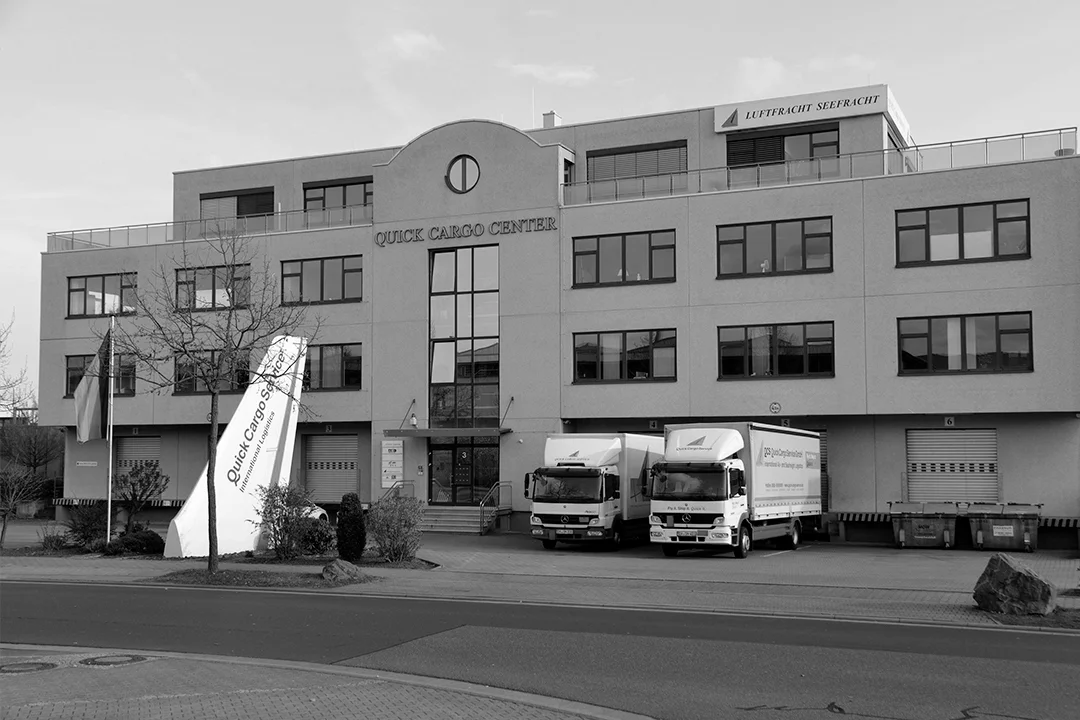In memory of 2016…or why there is a tailfin in front of our main building…
The new eye-catcher from Quick Cargo Service
A mystery is doing the rounds in Mörfelden-Walldorf: Question: Do you know the company Quick Cargo? Answer: No. Question: Do you know where the giant tail fin of an airplane is? Answer: Yes. On Kurhessenstrasse, in front of a shipping company. Statement: So you know Quick Cargo.
For a few weeks now, the eight-meter-high vertical tail of a Boeing 737 has been standing in front of the air and sea freight forwarding company’s headquarters – an eye-catcher that cannot be overlooked. The aircraft part was actually supposed to be set up in Berlin – and in an adventurous way it ended up on Kurhessenstrasse in the industrial area in Mörfelden.
When the call came in at the beginning of 2015, Robert Weckwerth was electrified. Quick Cargo Service was supposed to dispose of the old vertical tail of a Boeing 737-700. This was the order from the Berlin-based airline Germania. They actually wanted to set up the tail fin in front of their hangar at the new Berlin airport. They had it specially painted white in Dublin, Ireland, and had it brought to Berlin by QCS on a special transporter. But permission was not granted to set up the eye-catcher. The authorities had safety concerns because of the wind turbulence that often occurs at the airport and ultimately said no.
Robert Weckwerth, the QCS branch manager in Berlin, was supposed to take the eight-meter-high and 1,500-kilogram piece to the trash. It’s too bad, thought the experienced logistician, who had spent a good ten years of his professional life at QCS on Kurhessenstrasse and still had fond memories of the Lufthansa tailgate at the entrance to Gate 21 at Frankfurt Airport. “A super eye-catcher,” Weckwerth said to himself and said confidently: “What Lufthansa can do, Quick Cargo can do too.”
Weckwerth called Stephan Haltmayer and didn’t have to break down the door. “That’s what we’ll do” was the junior boss’ brief comment. Stephan Haltmayer also knew immediately: “This is the best advertising for us.”
After all, the medium-sized logistics company with around 200 employees across Europe makes around ten percent of its sales from aircraft spare parts, which are flown around the world wherever they are needed.
It was a wise decision not to scrap the tailplane. Especially since, as Stephan Haltmayer’s internet research turned out, the Boeing 737 that was part of the tailplane was a world champion jet. The plane with the registration D-AGEM took off from the Boeing factory in Seattle at 4:26 p.m. on March 11, 1998 and landed in Berlin-Tegel at 10:53 a.m. the next day after traveling 8,117 kilometers. No aircraft in the 60 to 80 ton takeoff weight class had ever flown this far. And all in 9 hours and 27 minutes.
D-AGEM was the first Boeing 737-700 delivered worldwide. In 1995, Germania ordered twelve aircraft of this type from the 737 Next Generation Family.
While D-AGEM is still flying today, the tail unit was probably replaced during a major check – and was then unnecessary.
Stephan Haltmayer spontaneously said yes during the phone call with Robert Weckwerth. But then the problems began. Easy to set up. Such a huge piece, at least eight meters high, could also be knocked down by the storm in Mörfelden-Walldorf and endanger people. Therefore, permission to “set up an advertising system” had to be obtained first. At least the “Building Regulations and Housing” department of the Groß-Gerau district did not report any fundamental concerns, but made it a requirement that the “recognized rules of technology and in particular those of stability must be observed”. And: QCS first had to create a photomontage of how the part fits into the surroundings and also submit the static calculation for a foundation.
Nothing worked without a foundation. Because a scaffolding should first be installed on the concrete base and on which the tail fin should be installed. All of this cost a lot of time and even more money. The transport was the fastest. The truck completed the Berlin – Mörfelden-Walldorf tour in a single day.
At the end of December last year the time had come. Jürgen Berger from the metal construction company Wulf & Berger in Büttelborn took the 1,500 kilograms onto the crane’s boom and initially had to struggle more with the gusty wind than with the weight of the tail fin. Because the placement of the steel colossus was a matter of millimeters and the wind was its greatest enemy. The mounting holes for the tail unit had to fit exactly with the corresponding holes in the steel base frame. According to the structural engineer’s calculations, the frame itself was mounted on a concrete slab four by two meters wide and one meter thick, with special screws that were two centimeters thick and an impressive 34 centimeters long and made the men from Wulf & Berger sweat profusely.
The icing on the cake finally came in March – the “Quick Cargo Service” lettering on the tail. Since then, the husband and wife in Mörfelden-Walldorf have known that QCS is where the tail unit of an aircraft is.
Senior boss Dieter Haltmayer, who was originally skeptical about his son’s idea, is now convinced: “There is no better eye-catcher for us.” That’s why he added a chapter to the English edition of his book “My Live in Freight”: “The Tail Fin of a Boeing 737 is the New Attraction at QCS Headquarters”.
Wolfgang Schubert

